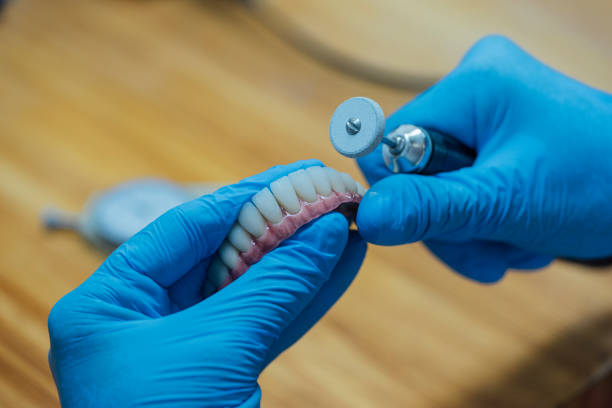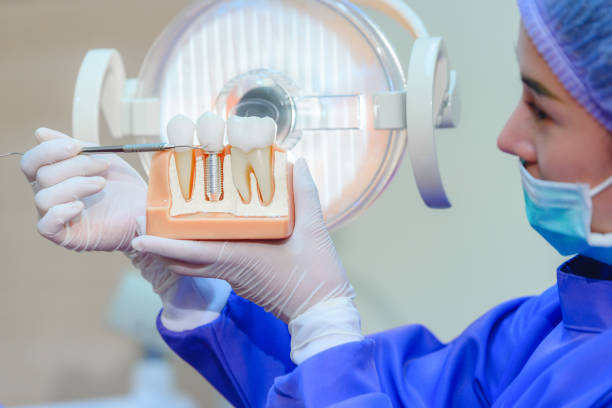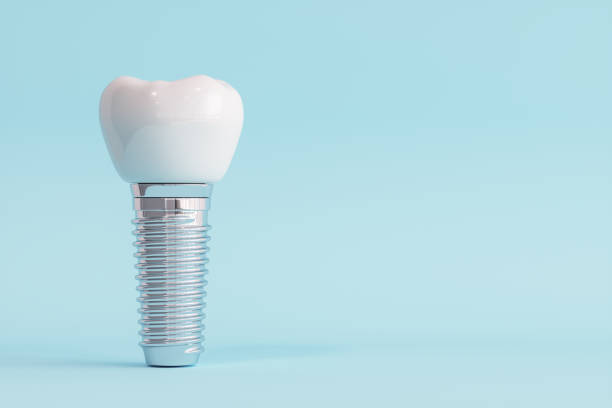By Dr. Miguel A. Estrella, DDS – TruSmile Dental Implant Center
If you’re missing teeth and exploring your options, you’ve likely come across two main solutions: dental implants and dentures. Both have their place in modern dentistry, but which one is truly right for your lifestyle, oral health, and long-term goals?
At TruSmile Dental Implant Center, we help patients make informed choices every day. In this article, I’ll break down the pros and cons of dental implants and dentures so you can confidently decide what’s best for your smile.
What Are Dentures?
Dentures are removable prosthetic appliances designed to replace missing teeth. There are two main types:
- Full Dentures: Replace all teeth in the upper or lower jaw
- Partial Dentures: Replace several missing teeth while preserving some natural ones
Dentures rest on the gums and are typically held in place by suction or dental adhesive. They are custom-made to match the appearance of your natural teeth.
What Are Dental Implants?
Dental implants are permanent tooth replacements made of titanium posts surgically placed into the jawbone. Over time, they integrate with your bone—a process called osseointegration—to provide a strong foundation for crowns, bridges, or full-arch restorations [1].
Implants don’t just sit on the surface of your gums; they mimic natural tooth roots and actively preserve jawbone density.
Comparing Key Features
1. Stability and Comfort
- Dentures: Can slip or shift while eating or speaking. Often require adhesive.
- Implants: Securely anchored into the jawbone. Function like natural teeth. No slippage or clicking sounds.
🟢 Winner: Dental Implants
2. Jawbone Preservation
- Dentures: Do not stimulate the jawbone. Over time, this can lead to bone loss and facial sagging [2].
- Implants: Actively preserve and stimulate bone, helping maintain facial structure [3].
🟢 Winner: Dental Implants
3. Longevity
- Dentures: Typically last 5–8 years and may require relining or replacement.
- Implants: Can last 25+ years or even a lifetime with proper care [4].
🟢 Winner: Dental Implants
4. Aesthetics and Function
- Dentures: Can appear natural, but may lack the feel and function of real teeth.
- Implants: Custom-made to match your smile. Feel and function like real teeth.
🟢 Winner: Dental Implants
5. Cost and Insurance
- Dentures: Lower upfront cost. Often covered by insurance.
- Implants: Higher initial cost, but lower long-term maintenance. May not be fully covered.
🟠 Winner: Depends on your priorities
💡 Note: Implants are a long-term investment in your oral health, while dentures may seem more affordable initially but require more upkeep over time.
6. Maintenance and Care
- Dentures: Must be removed nightly and cleaned separately.
- Implants: Brushed and flossed like natural teeth. No special adhesives required.
🟢 Winner: Dental Implants
When Dentures May Be the Better Choice
While dental implants offer significant advantages, dentures may still be the preferred solution if:
- You’re not a candidate for surgery due to medical issues
- You have significant bone loss and aren’t ready for grafting
- You’re seeking a short-term or budget-friendly solution
That said, many patients who start with dentures eventually transition to dental implants for comfort and improved quality of life.
The TruSmile Approach
At TruSmile Dental Implant Center, we offer both traditional dentures and advanced dental implant solutions. During your consultation, we’ll evaluate:
- Bone health using 3D CBCT imaging
- Your medical and dental history
- Lifestyle preferences and goals
- Budget and insurance options
From there, we’ll walk you through all your treatment options and build a plan that fits you—not just your mouth, but your life.
Final Thoughts
When it comes to replacing missing teeth, there’s no one-size-fits-all answer. But if you’re looking for maximum comfort, function, and longevity, dental implants are hard to beat.
Ready to explore your options? Schedule your consultation with TruSmile Dental Implant Center and let’s create a solution that restores your confidence—one tooth at a time.
References:
- Albrektsson, T., et al. (1986). The long-term efficacy of currently used dental implants: A review. Int J Oral Maxillofac Implants, 1(1), 11–25.
- Atwood, D. A. (1971). Reduction of residual ridges: A major oral disease entity. J Prosthet Dent, 26(3), 266–279.
- Misch, C. E. (2015). Dental Implant Prosthetics (2nd ed.). Elsevier.
Buser, D., et al. (2012). 10-year survival and success rates of 511 titanium implants with a sandblasted and acid-etched surface. Clin Oral Implants Res, 23(1), 8–16.



